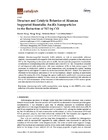Structure and catalytic behavior of alumina supported bimetallic au-rh nanoparticles in the reduction of NO by CO

Open access
Date
2019-11Type
- Journal Article
Abstract
Alumina-supported bimetallic AuRh catalysts, as well as monometallic reference catalysts, were examined with regard to their structural and catalytic properties in the reduction of NO by CO. Depending on the molar ratio of Au:Rh, the nanoparticles prepared by borohydride co-reduction of corresponding metal salt solutions had a size of 3.5–6.7 nm. The particles consisted of well-dispersed noble metal atoms with some enrichment of Rh in their surface region. NO conversion of AuRh/Al2O3 shifted to lower temperatures with increasing Rh content, reaching highest activity and highest N2 selectivity for the monometallic Rh/Al2O3 catalyst. This behavior is attributed to the enhanced adsorption of CO on the bimetallic catalyst resulting in unfavorable cationic Rh clusters Rh+-(CO)2. Doping with ceria of AuRh/Al2O3 and Rh/Al2O3 catalysts increased the surface population of metallic Rh sites, which are considered most active for the reduction of NO by CO and enhancement of the formation of intermediate isocyanate (-NCO) surface species and their reaction with NO to form N2 and CO2. Show more
Permanent link
https://doi.org/10.3929/ethz-b-000378060Publication status
publishedExternal links
Journal / series
CatalystsVolume
Pages / Article No.
Publisher
MDPISubject
alumina-supported AuRh nanoparticles; ceria doping; in situ DRIFTS; nitric oxide reduction with carbon monoxide; reaction mechanismMore
Show all metadata


